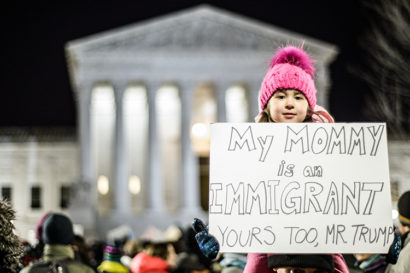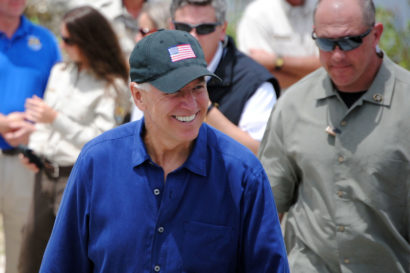The alt-right, Antifa and ‘Trumpism’
Director of federal relations Gina Daly sits down with Larry Rosenthal, the chair of the Center for Right-Wing Studies, to talk about the rise of Trumpism, what it needs to stay strong and what it will take to win the next presidential election
October 25, 2017
After white supremacists and counterprotestors violently clashed in Charlottesville in August, the dynamics behind “Trumpism” were on national display, says Larry Rosenthal, the chair of the Center for Right-Wing Studies at UC Berkeley. Gina Daly, the director of federal relations at UC Berkeley, sat down with Rosenthal, who discussed the rise of Trumpism, how much is too much for the American public and who could take on Trump in the next presidential election.
Gina Daly: To what do you attribute the rise of Trumpism?

Larry Rosenthal is the chair of the Center for Right-Wing Studies and Gina Daly is the director of federal relations at UC Berkeley. (UC Berkeley photo by Anne Brice)
Larry Rosenthal: There are two prominent explanations for Trumpism: One is economic and the other is cultural. The cultural is about white identity politics — the sense of “the country being taken away from us” by women and minorities. The economic argument is that the American middle class has been eviscerated, which is true. The condition of the American working class has been on a decline since 1973. It’s been kind of a wave that crested with the financial crisis of 2008.
What group of voters led to Trump’s electoral victory?
People who lived in corners of the American population, but were outside of the world of electoral politics — anti-Semites, KKK, neo-Nazis. They were beyond the pale in national politics. Imagine if you were one of those people, and suddenly at the level of presidential politics, someone is talking your language. It was startling, electrifying. These people were mobilized in a way that took them by surprise, and they — what we now call the alt-right — became part of Trump’s constituency.
Would you say the Antifa group is a threat, or actually creating a positive in the alt-right’s perspective?

Fighting in the streets in Charlottesville (Photo by Karla Cote via Flickr)
There’s no doubt — it’s a positive. The alt-right wants a movement that more resembles the politics of Weimar Germany, the period that gave rise to the Nazis. Richard Spencer, the president of the white supremacist National Policy Institute, said he never expected to be see this in his lifetime — the transition to fighting in the streets in that period. He believes that with fighting in the streets, Americans who are already polarized will be forced to choose between one extreme and another.
For those who voted for Trump, especially the Rust Belt American working class, how are they reacting to his policies?
I think the great question going into the Trump presidency was, “What’s going to happen to his base when they discover that the things he ran on aren’t about to happen?” The variations on the Affordable Care Act repeal would be disastrous to his base. But we’ve seen that the base has remained, apparently, quite firm. What are seen from the outside to be rational arguments — they do not seem to have displaced the identification with Trump as the person who is dissing the establishments of both parties. The capacity to place blame on the various establishments, and not Trump, remains quite strong.
What do you think Trump can say or do that will finally be so outrageous that people will say, “No, no, I cannot support this?”

A young protestor against Trump’s Muslim ban (Photo by Geoff Livingston via Flickr)
I don’t know. There have been dozens and dozens of issues — Muslim bans, pussy grabbing… the litany is extensive. And none of them has been a functioning third rail, which is the thing you step on and electrocutes you. I wondered, for example, if going after the NFL might be the third rail. Because on one hand, the racial component of it is attractive to his base. But on the other hand, they’re football fans, and Trump wants the owners to tell these star players they can’t play. Trump is undermining the NFL if the owners did what he’s telling them to do. It puts the base in somewhat of a quandary in a way that other issues haven’t.
In the upcoming midterm election in 2018 and in the presidential election in 2020, what will voters be looking for?
I tend to avoid such questions for many reasons, including my capacity to see the future is as dim as everybody else’s. In respect to the 2018 midterms — it’s a year from now. I don’t think that which has gone on so far is going to be determinative of what happens in a year from now. In 2013, the Republican Party, thanks to the Tea Party, shut down the government over Obamacare. The conventional wisdom was that they were going to suffer in the 2014 elections. They did just fine. The idea that which happens the year earlier is somehow of predictive, I find that a kind of faulty notion.

Rosenthal wonders if Joe Biden could withstand a character attack in a presidential election. (Photo by U.S. Army Corps of Engineers via Flickr)
It’s difficult to know who the candidates will be in the 2020 election, but what qualities might a candidate have to possess in order to take on Donald Trump?
Someone who might be able to challenge Trump, in my view, would be someone with the capacity to not be defined by a characterological smear, which Trump is sure to use and has been the Republican electoral strategy for some time. One wonders if the kind of folksiness, I-come-from-the-Rust-Belt quality of Joe Biden might withstand a character attack. Could Elizabeth Warren run for president and not be defined by Pocahontas? I think the issue is not so much vulnerability to a global characterization smear, but the ability to withstand it. That would be my strongest consideration.